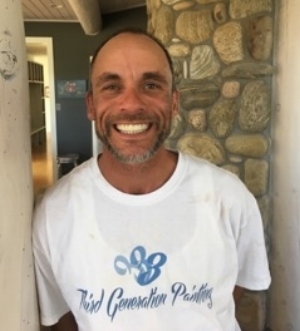The Story of a Real Tooth Fairy
This is Tim today.
Nobody had ever called me the Tooth Fairy, but about two years ago I acquired that nickname.
My husband, Ed, and I were redoing our place in Montana, and, like thousands of others in the West, we were going for that rustic, reclaimed-barnyard wood look. After the house had been gutted--think dusty, messy work site—Ed and I were stymied what to do with all the yellowed, knotty pine that lined every wall and every bookcase in his office.
A young painter on a ladder, dressed in customary paint-splattered whites, introduced himself as Tim. He jumped down from the ladder and said that with careful painting he thought he could transform the yellowed knotty pine into a faux weathered gray that would blend great with the barnyard wood floors and cabinets. He talked more like a designer than simply another member of the paint crew.
As this handsome and enthusiastic young painter suggested artistic ideas with a confident authority, he seemed knowledgeable and smart—until he opened his mouth and I saw that he had practically no teeth. Almost toothless, he seemed to me, dumb. I understand that this could sound harsh, and I know we’re not supposed to be judgmental, but let’s face it, if you were confronted with a toothless person like this you’d probably form a similar judgment.
Tim before the procedure.
I can’t explain what came over me, but on the spot it seemed unfair that this otherwise attractive and clearly talented young man—I thought Tim was 28; turns out he was 37—came across as so smart until I saw he was almost toothless. It also only seemed fair that if Ed and I could re-do a house we could help Tim re-do his teeth, if he wanted to.
Luckily, Ed agreed with me. I immediately spoke to the head paint contractor, and asked if he knew a dentist in town he trusted because we wanted to find out what would be involved in getting Tim teeth.
Just recently “The Story In Our Smiles” aired on NPR’s On Point. In this program, Tom Ashbrook, the host, explored the status of dental care today. He discussed the lack of access to dental care and preventative care among low income American adults that leads to rotting teeth, full extractions and dentures, and even death from dental infections. Ashbrook interviewed Mary Otto, the author of “The Story of Beauty, Health, Inequality, and the Struggle for Oral Health in America.” They discussed the giant disparity between those who can afford dental care and those who can’t.
Ashbrook and Otto might as well have been talking about the painter, Tim Dobbs. Tim grew up poor in San Bernardino, California. Too poor for dental visits. “Teeth were on the back burner, for sure,” he said. Then in high school a pole-vaulting accident nailed him on the mat and knocked out his front teeth. “I had a busted grill,” he explained. From there things went downhill pretty quickly: He had a life of decay, toothaches, not being able to eat, and massive pain. He said he’d hold his jaw and get in a hot shower for half-an-hour to try to reduce the pain.
After a consultation with dentist, Dr. Kenneth Van Kirk, came up with 3 plans for Tim: the cheapest—full mouth extraction and full dentures top and bottom; the most expensive—all implants; and a middle of the road approach—save the teeth he had, some implants, some crowns, and some partial dentures. The dentist didn’t think Tim, who had never had any dental care, could tolerate full implants. So we and the dentist opted for the middle plan.
I hate dental pain, and require a topical anesthetic when I’m just having routine dental hygiene work, so I warned Tim that this would hurt and be painful. It turned out that some of his dental visits lasted 2-3 hours.
After the temporary upper bridge, you could see progress. This was also when in front of the full construction crew Tim presented me, shyly, with a thank you bouquet of flowers. I had the distinct feeling that Tim Dobbs hadn’t bought many bouquets of flowers.
Tim with temporary upper bridge
When the extensive work required $5,000 more than the quote we’d agreed to, Tim painted the dentist’s office to make up the difference.
His dental reconstruction took two years, longer than it might have since unfortunately Tim was still a smoker, and the smoking left his gums tender and sensitive to the surgery.
Last week Tim, who just turned 40, and his mom, Norma Wells, who happened to be in town, stopped by to show off his new teeth.
“I feel like a million bucks,” he said “I got my smile back. I’m more personable. I have a happy, sexy-looking smile.” Though he admitted he didn’t have a girlfriend. Yet.
He proudly showed his mother our remodeled house, especially pointing out the tricky weathered faux gray paint in Ed’s study.
Then in front of his mother, Tim said, “Jo, tell me again why you helped me.”
“Because I believed in you,” I said.
As I learned from listening to Tom Ashbrook’s “The Story in Our Smiles,” there are millions of Tims out there who could use our help.
My mother, who was called Babe, always said, Charity begins at home. Tim was in our home, and once again, Babe was right.
Jo Giese, Tooth Fairy, Tim Dobbs, and his mom, Norma Wells
Jo Giese, author, award-winning radio journalist. Up next: Never Sit If You Can Dance: Lessons from Babe, a quirky mother-daughter memoir.




